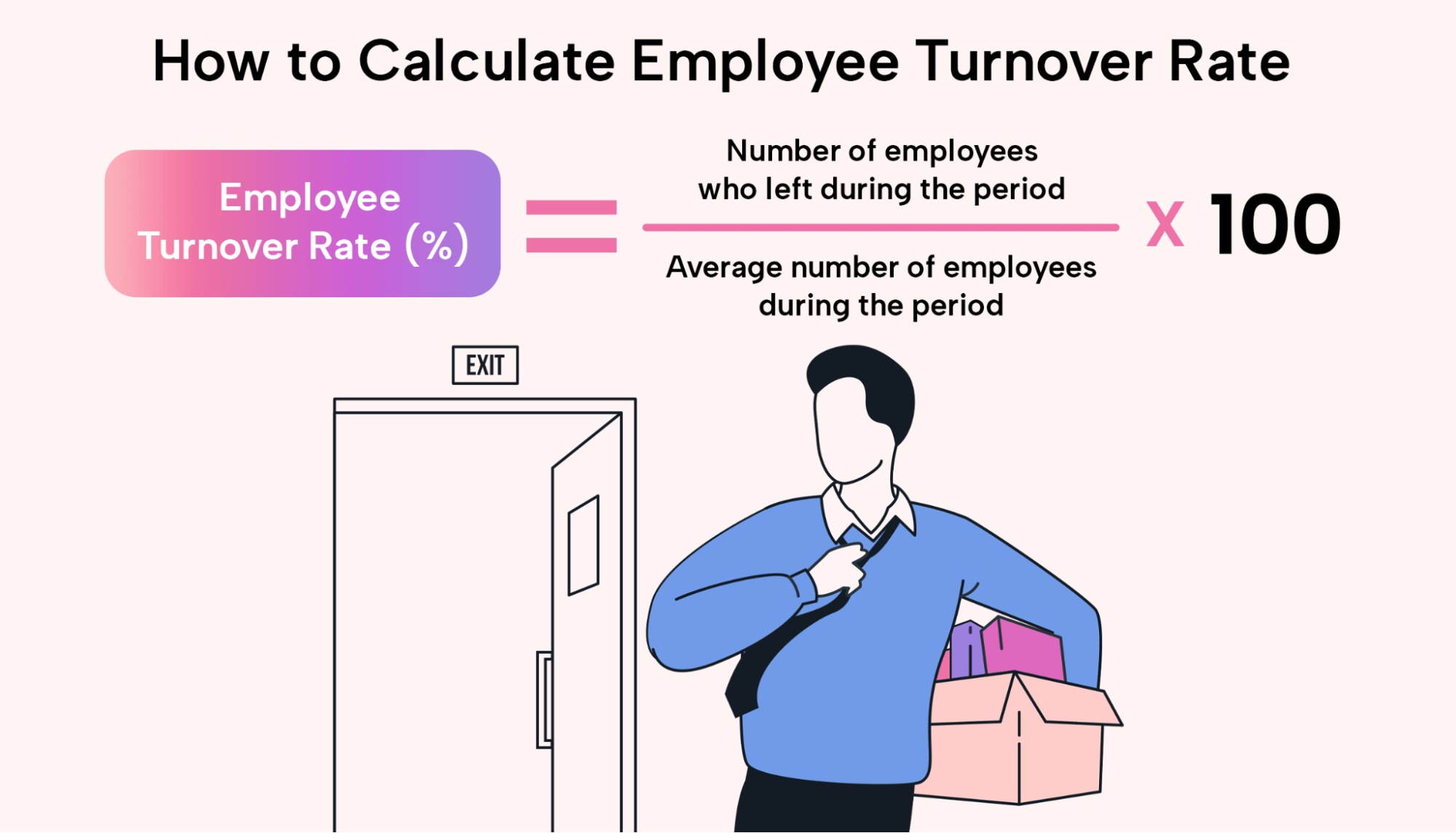As a business owner or HR manager, you’re keenly aware of the critical role employee retention plays in running your organization.
With high employee turnover rates emerging as a major workforce challenge for many companies around the world, it’s clear that the stakes have never been higher.
Ultimately, the path to a thriving company starts with how you engage, recognize, and retain your most valuable asset: your employees. This guide provides 16 actionable strategies for doing just that.
What is employee retention, and why is it critical?
Employee retention is the effort employers make to keep valuable staff members.
As the global workforce becomes increasingly mobile and competition for talent increases, hanging on to employees has become a pressing leadership and HR task. LinkedIn reports that “93% of organizations are concerned about employee retention.”
The reasons for these concerns are well-known. Companies with high turnover face challenges such as the following:
- The high costs of ongoing recruiting, hiring, and training
- Issues preserving company culture and institutional knowledge
- Difficulty maintaining customer satisfaction
- A lack of service continuity
One survey found that the average annual turnover cost for companies across the board is $57,150, with almost a quarter of companies reporting that turnover costs them $100K or more per year.
Trends in employee turnover and retention vary by industry. According to the U.S. Bureau of Labor Statistics, the average separation rate (employees leaving employment for personal reasons or due to being laid off or fired) for the private sector was 4.0% in 2023. The highest rates were found in the leisure and hospitality industry (6.7%) and the lowest in finance and insurance (2.0%).
Before looking at retention strategies, it’s helpful to be aware of your own company’s turnover rate to assist you in developing a targeted retention response.
How to calculate your employee turnover rate
Here’s a simple formula to help you determine your turnover rate:
 |
Notes:
The number of employees who left during the period is the sum of employees who exited the company during a specific timeframe (e.g., a month, quarter, or year).
The average number of employees during the period is calculated by adding the starting number of employees and the ending number of employees for the period and then dividing that amount by two.
Once you’re familiar with your company’s turnover rate, it’s time to explore effective retention strategies to stem the tide and hold on to your workforce’s best and brightest.
Proven retention strategies that motivate employees to stay
We’ll cover 16 retention strategies in this section, including practical tips on how to maximize their effects.
1. Offer competitive compensation packages
Companies that offer competitive salaries and benefits can reduce their turnover rates. Attractive compensation makes the company appealing to top talent and discourages workers from looking elsewhere — simultaneously helping companies avoid the significant expense of high turnover rates.
According to a Randstad report, 63% of employees in North America cite an “attractive salary and benefits” as the top value they look for in a prospective employer.
Tips:
- Make sure your salaries and benefits match or surpass industry standards.
- In addition to a base salary, consider regular bonuses, special health benefits, retirement contributions, and other perks.
- Annually review and update your compensation structures based on market trends.
 |
2. Signal business health
Also high on the list is a healthy outlook for the company — and communicating this outlook effectively and convincingly to both current and prospective employees.
Financially stable companies with a positive cash flow, minimal debt, steady profit margins, and regular financial reporting often see lower turnover as their employees feel secure about the company’s future. In fact, signaling robust company health can reduce employees’ desire to quit by 39%.
Tip:
- Communicate regularly and transparently about your company’s financial health, even during challenging times. This boosts employee confidence in the company’s long-term viability and lays the groundwork for ongoing loyalty and commitment.
3. Offer flexible work arrangements
Firms that offer remote work or flexible hours report increased employee satisfaction and retention. These arrangements are known to boost employee morale by reducing commute time and offering more personal freedom.
According to a Gallup poll, more than 70 million US workers can do their jobs remotely, and 60% would like a long-term hybrid work arrangement.
The same poll found that “six in 10 exclusively remote employees are ‘extremely likely to change companies’ if not offered remote flexibility,” and “three in 10 hybrid employees are ‘extremely likely to change companies’ if not offered remote flexibility.”
Tips:
- Experiment with offering remote work options, flex time, and compressed work weeks.
- For maximum results, equip employees with the tools they need for seamless remote collaboration.
- Cultivate a culture in which output matters more than the hours put in.
4. Provide professional development opportunities
Many employees say they’d stay with a company that invests in their growth.
According to a LinkedIn report, after “compensation and benefits” and “flexible work,” the three most important factors for employees to remain at a company are “doing challenging and impactful work,” “opportunities for career growth within the company,” and the “opportunity to learn and develop new skills.”
Tips:
- Offer workshops, training programs, certifications, and advanced education.
- Match these growth opportunities with the company’s business goals so employees will have practical avenues through which to practice their new skills.
- Help employees feel valued and envision a future within the company.
5. Invest in recognition and rewards
Regular employee and team success recognition boosts morale and encourages continuous high performance. It creates an environment of gratitude and a sense of belonging that can significantly reduce turnover.
Tips:
- Regularly acknowledge employee milestones, achievements, and contributions.
- Offer employee-of-the-month awards, team awards, bonuses, public recognition, company-wide appreciation events, and other employee recognition ideas.
 |
6. Develop a strong company culture
Companies with a defined and positive culture see higher employee retention rates. Culture includes a clearly articulated mission, vision, and set of values and beliefs. It’s also how leaders and employees treat and respect each other.
You can develop a strong culture no matter where people are working. According to a Glassdoor report, “the three most important determinants of employee satisfaction have little to do with in-person offices and can be cultivated in fully remote work environments.” These determinants are (1) a compelling company mission that links the business to the greater good of society; (2) transparent, empathetic senior leadership; and (3) clear career pathways for employees.
Tips:
- Involve your employees in cultural decisions and events.
- Aim for and demonstrate a sense of belonging and shared purpose in your communications and actions.
- Make sure the desired company culture is mirrored in your behavior, the company’s day-to-day operations, and employee interactions.
7. Implement an effective onboarding process
Proper integration of new employees can lead to higher retention in the first year of someone’s employment due to faster role adaptation and increased early-stage productivity.
Tips:
- Provide a comprehensive overview of the company workplace culture, job roles, and expectations before introducing new hires to the rest of the employees.
- Help new hires build relationships and networks within the company for faster integration.
- Check in with new hires regularly at the beginning of their employment to address any concerns that may arise.
8. Organize employee engagement activities
Engaged employees are more likely to stay than unengaged “silent quitters.” Engagement can enhance team cohesiveness and improve the workforce’s morale.
Tips:
- Organize team-building exercises, company outings, and shared interest groups to bring employees closer together.
- Engage employees in decisions about activities and events.
- Offer activities at regular intervals to ensure ongoing engagement.
 |
9. Offer a diverse and inclusive environment
An established, welcoming culture that encourages diversity provides a richer workplace experience, making it easier for employees to feel at home and want to stay at the company.
Tips:
- Implement a diversity-oriented, bias-free hiring process into your recruitment practices.
- Offer regular workshops on inclusion, unconscious bias, and cultural competency.
- Celebrate diverse holidays, traditions, and events to cover the spectrum of backgrounds within your workforce.
10. Maintain open communication channels
Employees, in general, feel more committed when communication is effective and they believe their voices are heard.
Tips:
- Use communication platforms and tools that facilitate open dialogue.
- Make sure management is available for all employees by maintaining an open-door policy.
- Regularly invite input from individuals at varying staff levels to find out how they perceive the company’s communication channels, and make improvements as needed.
11. Provide mentorship and peer support programs
Mentored employees report higher job satisfaction and commitment. Both mentors and mentees benefit from the fresh perspectives these interactions provide.
Tips:
- Pair newer employees with seasoned ones for questions, training, and guidance.
- Aim for a climate of accelerated learning and networking that engenders increased job satisfaction.
- Allow for roles to change as the mentor-mentee relationship evolves.
12. Offer health and wellness initiatives
Wellness programs can increase retention by helping employees feel valued beyond their work contributions. Better health translates to reduced absenteeism and increased productivity.
Tips:
- Consider fitness memberships, mental health resources, and wellness challenges.
- Provide time off for health, relaxation, and recovery.
 |
13. Give regular feedback and conduct performance reviews
Employees who receive regular constructive feedback (quarterly, semi-annual, or annually) feel more valued and are more likely to stay than those who don’t.
According to a 2023 Gallup study, “meaningful feedback sessions involve recognition, discussion about collaboration, goals and priorities, and the employee’s strengths. This is the activity that prevents employees from feeling disconnected from the organization because managers stay in touch with what each employee is contributing and can then articulate how that work is impacting the larger organization.”
Tips:
- Include both positive feedback and areas for improvement in employee reviews.
- Align feedback with growth opportunities and employee-specific training.
- Aim for continuous professional growth by setting clear expectations going forward.
14. Present opportunities for advancement
Clear career paths reduce talent loss to competitors.
A CareerBuilder survey found “a desire for a career shift among job seekers, including seven in 10 employed adults who are currently engaged in a job search, either actively or passively.”
Tips:
- Be transparent regarding career paths and promotion criteria.
- Offer training and tools to help employees reach the next level in their careers.
- Motivate your employees, as they will likely work harder if they know there’s room for growth.
15. Implement healthy work-life balance initiatives
Many employees prioritize a good work-life balance over a higher salary. A better balance increases productivity and reduces burnout.
A good work-life balance ranks consistently among the top five drivers of employee satisfaction. For white-collar workers, it ranks 2nd at 58%, and for blue-collar workers, it comes in 4th at 51%.
Tips:
- Offer flexible work arrangements, such as one or more “work from home” days each week or allowing varying start and end times in the workday.
- Provide ample vacation days, personal days off, and mental health breaks.
- Avoid work-related communication during off-hours.
16. Conduct exit interviews
Learning from departing employees about the reasons behind their departure will give you valuable insights that you can implement to adjust your retention strategies and reduce future turnover rates.
Tips:
- During exit interviews, use a mix of structured questions and open-ended discussions to solicit the best possible responses.
- Analyze the feedback to identify patterns and areas for improvement.
- Implement fact-based changes to reduce future turnover rates.
 |
Adapting general retention strategies to your company
The importance of recognizing company-specific challenges and needs and aligning your retention strategies with your business goals cannot be overstated.
So, take a careful look at the role of leadership and management in retention and tailor your strategies. Not every strategy will fit every company, so pick and choose the ones that apply to your unique situation.
In addition to a top-down analysis of why your workers stay and leave, it’s helpful to get feedback from your employees themselves to find out what matters to them in terms of working for your company. Use employee surveys or feedback sessions to do this.
Also, remember to practice continuous monitoring and adjustments to make sure the strategies you select remain effective.
Use online tools for optimal employee retention
While a robust retention strategy is multifaceted, as we’ve shown, incorporating the right tools can make a world of difference.
Consider how integrating intelligent calendar and project manager software, like those offered by Motion, can revolutionize the employee experience.
Ensuring a streamlined workflow, clear project timelines, and efficient scheduling with Motion not only boosts productivity but also shows your team you’re invested in their success.
By embracing innovative tools like Motion, you’re making a strategic move to keep your top talent engaged, satisfied, and on board. Try Motion for free for 7 days.





